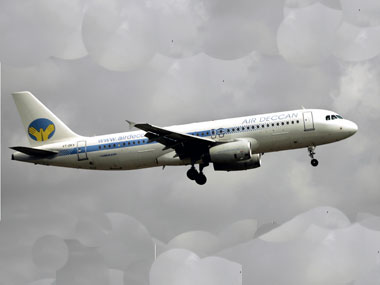Airline fares are set to rise again - and again. And the writing on the wall is clear.
BusinessLine reports that the government is “well-disposed” to a request from private airlines to raise fares, though one wonders why private airlines should be worried about taking the government’s tacit permission for it. Aren’t they private precisely because they don’t need the government’s permission to set their own prices?
But there are five reasons why no matter what the government does, airline fares will keep rising.
[caption id=“attachment_109471” align=“alignleft” width=“380” caption=“The erstwhile Air Deccan. Reuters”]  [/caption]
One, there is no such thing as a really low-cost airline. We have low-fare airlines, and inefficient airlines (Air India, for one). But low-cost? We have wrongly categorised low-fare airlines as low-cost. We can have low-cost airlines when we have low-cost airports.But this is far from being the case. In India, fuel costs the same, airport charges are the same, and staff costs are not too different. The only real differences in cost relate to mode of financing, age of aircraft, and intensity of use. This is where SpiceJet and IndiGo score.
Once all airlines learn the same tricks - of financial engineering and flogging their aircraft more - India will have only low-fare airlines, and they may not be lower cost. If this happens, fares can only go up as margins will have to come from product differentiation.
Two, the field is gradually going to narrow down, with fewer players. The exit of Kingfisher Airlines from the low-fare business is a sign of the times. Paramount and MDLR went out some time ago. Sahara and Deccan went before them. But in the initial flurry of enthusiasm, the buyers of Sahara and Deccan retained their low-cost operations. But Kingfisher’s exit confirms that airline managements cannot defy the laws of economics for too long.
Three, Air India’s huge losses will force the government to allow private airlines to raise fares. There is no way the government can bail out Air India or allow it to go bust. With last year’s losses at Rs 7,000 crore and debt piling up to over Rs 42,500 crore, Air India needs higher fares to stay in the black even at the operating profit level. Hence, the government will quietly encourage airlines to raise fares. If it does not do so, it will have to keep Air India on permanent life-support - and it does not have enough cash to keep doing this.
Impact Shorts
More ShortsFour, the fall in the rupee against the dollar is another factor favouring fare rises. Quite apart from the fact that aviation fuel prices are sensitive to the international price of oil, the problem is almost all costs - barring employee and airport charges - are denominated in dollars. Aircraft are leased in dollars, and even loans are in dollars. This means debt servicing costs will rise as the rupee falls.
Five, airports are now planning to push for higher charges. The Delhi International Airport Ltd is set to lose Rs 825 crore in the year ending March, 2012, and is lobbying hard for an increase in landing and other airport charges. The situation cannot be too different at the other airports, and the Airports Economic Regulatory Authority (AERA) might allow a hike in landing and parking charges as private operators lobby for relief.
When costs are on the rise on all fronts, the only conclusion is this: low-fares are on their way out.


)

)
)
)
)
)
)
)
)



